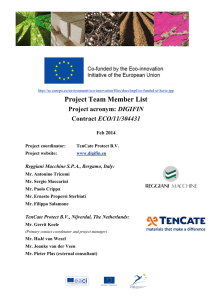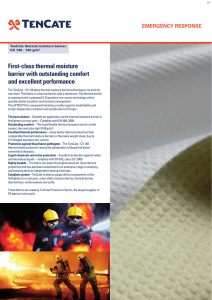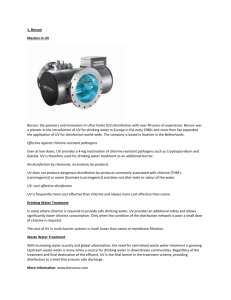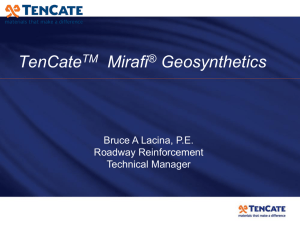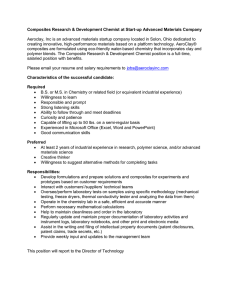CFRT Material Forms - SPE Automotive Division
advertisement
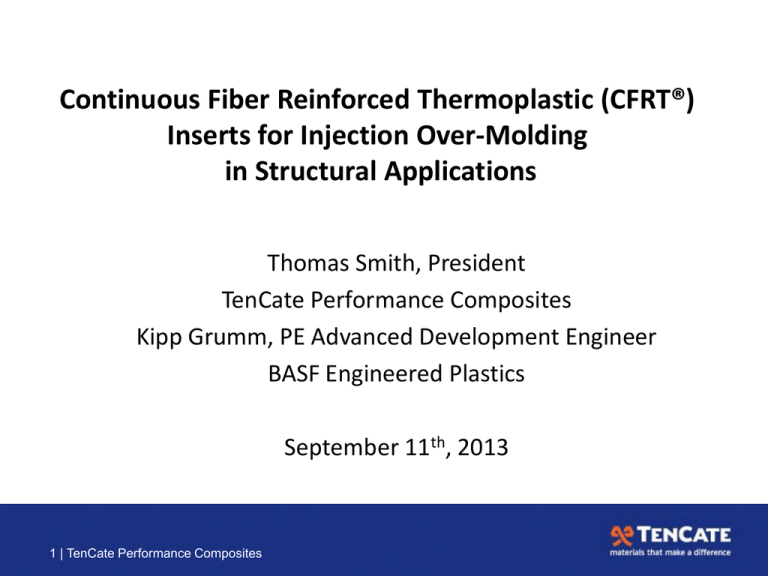
Continuous Fiber Reinforced Thermoplastic (CFRT®) Inserts for Injection Over-Molding in Structural Applications Thomas Smith, President TenCate Performance Composites Kipp Grumm, PE Advanced Development Engineer BASF Engineered Plastics September 11th, 2013 1 | TenCate Performance Composites Overview • A primary goal in automotive structures is reduction of weight while maintaining or improving other desirable attributes. • Composite materials offer weight reduction solutions in comparison to metal structures. • Thermoplastic composite materials (in comparison to thermoset) offer the added potential benefits of – Improved cycle times, – High impact resistance, – Cost effective solutions, – Integration in known plastic processes – A better path for sustainability. TenCate Proprietary 2 | TenCate Performance Composites Overview • Injection over molding of structural inserts produced from continuous fiber reinforced thermoplastics (CFRT®) is a valid method for producing structures with reduced weight. • The concept is to combine the advantages of injection molding and CFRT properties to produce strong lightweight structures that have integrated features and improved design styling. • CFRT® materials have substantially higher mechanical properties than molding compounds, but they can be integrated directly in the molding process. • Potential applications for over-molded CFRT inserts are in seat structures, airbag housings, front end modules, crash beams and other structural applications. • A seat back application is used as a case study for CFRT overmolding. TenCate Proprietary 3 | TenCate Performance Composites Continuum of Thermoplastic Materials • • • • • Neat Thermoplastic (NT), Short Fiber Thermoplastic (SFT), Glass Mat Thermoplastic (GMT), Long Fiber Thermoplastic (LFT) and Continuous Fiber Reinforced Thermoplastic (CFRT) also known as Endless Fiber (EF) • Through the thermoplastic continuum, the mechanical properties and the complexities of making parts increase. • CFRT has the highest mechanical properties in the continuum of thermoplastic materials. TenCate Proprietary 4 | TenCate Performance Composites Comparative Mechanical Properties • CFRT produced with PA6 and glass fiber has been used in the design of a structural insert for a seatback. • CFRT has improved strength and impact characteristics over metals and thermoplastic SFT and LFT. • Specific strength (S/ρ) is used to compare materials. • PA6/glass CFRT has specific strength three to four times greater than that of aluminum and steel. Note that values for CFRT are in the fiber direction only. TenCate Proprietary 5 | TenCate Performance Composites TenCate Proprietary 6 | TenCate Performance Composites Impact Characteristics 700 PA6 GF50 23°C 600 PA6 LGF40 23°C PA6 CFRT 23°C Energy [J] 500 400 300 200 100 0 0 10 20 30 40 Time [ms] 7 | TenCate Performance Composites 50 60 70 TenCate Proprietary Simple CFRT Example TenCate Proprietary 8 | TenCate Performance Composites TenCate Proprietary 9 | TenCate Performance Composites Polymer and Continuous Fiber TenCate Proprietary 10 | TenCate Performance Composites CFRT Material Forms • CFRT materials are produced by combining the polymer matrix and fiber reinforcement such that the fibers remain continuous. • Two basic fiber formats are used for CFRT. – Uni-directional (UD) fibers which are spread to be made into tapes which can be laminated into sheets, slit and woven or braided, placed into engineered kits and used for tape laying and winding. – Woven or braided forms which are made into sheets. • There are pros and cons to each of the fiber formats with respect to properties, costs, design flexibility, ability to process and other factors. TenCate Proprietary 11 | TenCate Performance Composites CFRT Material Forms • The polymer is applied to the fiber in various forms. – Polymer filaments may be commingled with the fiber – Polymer may be directly melted from pellet – Polymer can be ground into powder which can be applied in a dry form or an aqueous slurry – Polymer may be converted to a film. – Polymer may have its viscosity reduced using a solvent. • As with the fiber formats, there are pros and cons to each of the polymer forms used. TenCate Proprietary 12 | TenCate Performance Composites CFRT Material Forms (UD Tape) TenCate Proprietary 13 | TenCate Performance Composites CFRT Material Forms (Woven Sheets) TenCate Proprietary 14 | TenCate Performance Composites CFRT Material Forms • There are several proprietary processes for the production of CFRT materials. • The objective in producing CFRT, as in all structural composites, is to completely impregnate (wet-out) the fibers and to obtain good interfacial adhesion between the polymer and the fiber. • Due to the higher viscosities of thermoplastic resins, this is a challenge particularly at higher fiber volumes and with certain fiber polymer systems. TenCate Proprietary 15 | TenCate Performance Composites Fabrication Methods for CFRT • One of the major advantages of CFRT as compared to thermoset composites is a rapid production cycle (comparable to injection molding cycles). • CFRT materials are converted into parts by some or all of the following steps – Converting the material into an engineered kit or a sheet – Cutting of CFRT into a 2D form – Heating of the CFRT – Molding of the CFRT – Cooling of the CFRT – Finishing of the CFRT (trimming, etc.) TenCate Proprietary 16 | TenCate Performance Composites Fabrication Methods for CFRT Engineered Kit Examples TenCate Proprietary 17 | TenCate Performance Composites Fabrication Methods for CFRT (Cutting) • Cutting of CFRT can be performed in a flat or molded shape • Methods of cutting CFRT – Shearing – Stamping – Waterjet – Laser – Router – Others • Materials are cut at room temperature in a non-tacky state. • Cut pieces are easy to handle TenCate Proprietary 18 | TenCate Performance Composites Fabrication Methods for CFRT (Molding) • Thermoforming where material is pulled over the mold by holding the edges or a bladder conforms the material. • Plug Assist which uses a metal core or cavity and a plug made from a compliant material as the opposite half of the mold. • Matched Metal (Compression Molding) which either uses a free edge or captured edge. • Dual Compression process where CFRT is molded with LFT. • Dual Compression Injection process where the CFRT® material is molded during the injection process. • Internal Molding where a bladder is used to mold the material against a closed tool. TenCate Proprietary 19 | TenCate Performance Composites Compression Molded Non-Captured Edge TenCate Proprietary 20 | TenCate Performance Composites Compression Molded Captured Edge TenCate Proprietary 21 | TenCate Performance Composites Fabrication Methods for CFRT (Heating and Cooling) • At the core of the CFRT molding processes are the heating and cooling technologies that are employed. • The materials must either be heated outside or inside of the mold depending upon: – Material capacitance – Thickness – Degree of molding complexity – Transfer time and – Polymer and fiber system used. • Even when materials are heated in the mold, they may be preheated external to placing in the mold. TenCate Proprietary 22 | TenCate Performance Composites Fabrication Methods for CFRT (Heating and Cooling) • From an energy use standpoint, heating of the material outside of the mold is most efficient. • However, some designs require that the material be heated or held at temperature for a period of time in the mold which requires that the mold must be heated and cooled during each cycle. • Heating of the material outside of the mold is performed with convection, conduction, radiation or combination of the three. • The tool is normally maintained at a constant temperature which is hot enough to allow molding to be completed to the desired shape, but cool enough to provide for a rapid cycle time. • Using this technique, mold cycle times (part to part) can be on the order of 30 to 60 seconds for materials that are 4-6 mm in thickness. TenCate Proprietary 23 | TenCate Performance Composites CFRT Part Complexity Achievable Materials Heated Outside of Tool Cycle Time < 1 min Wall Thickness – 5 mm TenCate Proprietary 24 | TenCate Performance Composites Fabrication Methods for CFRT (Heating and Cooling) • If the material must be heated by the mold, then various techniques have been used. They typically are based upon external or internal heating and cooling of the molds. • The objective is to use the least energy and fastest cycle time possible while meeting the desired quality requirements. • Heating and cooling of the materials in the mold require that active “heater and cooler” systems be employed. • Internal heating of molds is performed with either electrical heaters, inductive heating, hot oil or water (steam) or hot gas (e.g. - air). • Cooling is performed convectively by either oil, water or gas or by conduction via a plate. Note that uniform heating and cooling is required to minimize stresses and part warp. • The systems must switch between an active heating mode to an active cooling mode during a given molding cycle. The goal is to time the transient behavior for optimal cycle time and energy utilization. TenCate Proprietary 25 | TenCate Performance Composites Fabrication Methods for CFRT (Heating and Cooling) • Highly complex and dimensionally tolerant parts with excellent surface finishes have been produced with CFRT using these processes. • Parts with wall thicknesses less than 1.0 mm in thickness have been successfully produced. Details such as bosses, ribs, undercuts, etc. have been molded with the CFRT materials. • Mold heat and cool cycle times have been achieved at 2 to 4 minutes for molding of CFRT parts similar to those for automotive applications using the techniques available today. • These cycle times are expected to continue to improve as there is active ongoing research and development for heating and cooling for molding of thermoplastic composites. TenCate Proprietary 26 | TenCate Performance Composites CFRT Part Complexity Achievable Tool Inductively Heated and Water Cooled High Level of Detail Thickness - 0.8 mm TenCate Proprietary 27 | TenCate Performance Composites Injection Over-Molding of CFRT Inserts • CFRT can be placed in an injection molded part to greatly increase the performance. • The CFRT provides strength and stiffness where needed and injection molding provides detail, parts integration, etc. • In certain cases, the continuous fiber part can be formed in the injection molding tool prior to over-molding • For complex parts, the CFRT is used as an insert in the overmolding process. • The goal in the over-molding process is to achieve flow around the CFRT where desired and to obtain good bonding between the materials. TenCate Proprietary 28 | TenCate Performance Composites Seat Back Project Objectives • A seatback frame was produced by injection over molding a CFRT insert to replace an existing metal system. • The following objectives were outlined for the project. – – – – – – Reduce overall weight, Reduce seat thickness, Integrate features, Improve styling, Seatback cost neutral Tooling/Equipment to be less expensive TenCate Proprietary 29 | TenCate Performance Composites CFRT Material Development for Seatback Application • A CFRT material was developed from a specific grade of PA6 resin to be compatible with a defined injection over-molding resin. • The material was developed in both glass and carbon fiber. The glass material was used in the seatback for cost reasons. • The glass fiber content was 65% by weight. • The tape thickness was 0.25 mm • Key considerations in selection of the CFRT resin were – Melt temperature relative to the injection resin – Adhesion characteristics with injection resin – Ability to process into high quality CFRT TenCate Proprietary 30 | TenCate Performance Composites Over-Molding Bonding • Bond testing was performed to select the polymer and process conditions to achieve the best level of adhesion. • The test results were used in analysis of the over-molded inserts in a simulated crash environment. TenCate Proprietary 31 | TenCate Performance Composites Laminate and Component Design and Structural Analysis • A laminate was designed to meet expected stress levels from the crash environment • The laminate was designed with six layers with ply orientation of 0/90/0/0/90/0 at 1.5 mm total thickness. • The fiber orientation was selected to increase strength in the primary load direction. • Simulation software was used to model the component as over molded in the seatback. TenCate Proprietary 32 | TenCate Performance Composites Component Level Testing and Analysis TenCate Proprietary 33 | TenCate Performance Composites Component Development and Production UD Tape with Desired Properties Molded Part Designed to Survive Crash Laminated Sheet with Desired Properties Trimmed Ready for Insert Molding TenCate Proprietary 34 | TenCate Performance Composites Inserts Overmolded and Assembled into Finished Seatback TenCate Proprietary 35 | TenCate Performance Composites Seatback with Over-Molded CFRT Inserts Successfully Developed Volume Reduction – 16 liters Weight Reduction - 6 lbs Thickness Reduction – 1 inch 36 | TenCate Performance Composites TenCate Proprietary The Next Steps • Expanded material databases for CFRT materials • Design guidelines for CFRT components • Tools for modeling (e.g. – crash environments) • Processing capabilities for parts and processing guidelines • Design with CFRT in mind to achieve the maximum benefits. TenCate Proprietary 37 | TenCate Performance Composites Acknowledgements and Thanks • Thanks for the leadership of BASF and Faurecia on this project. • Thanks to the ACEE for allowing us to present this information. • Please feel free to contact us for further information. TenCate Proprietary 38 | TenCate Performance Composites
